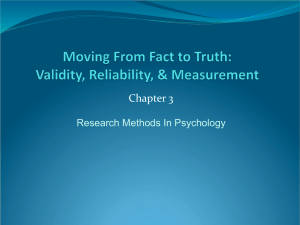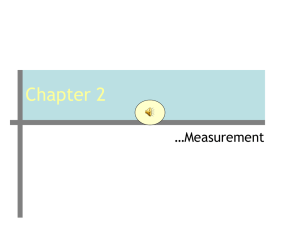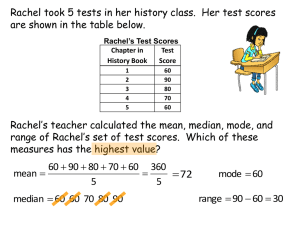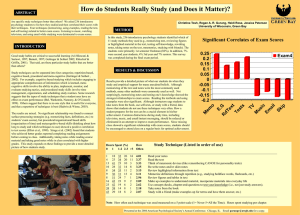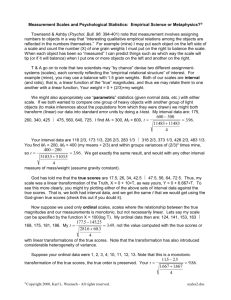An introduction to measurement and evaluation
advertisement
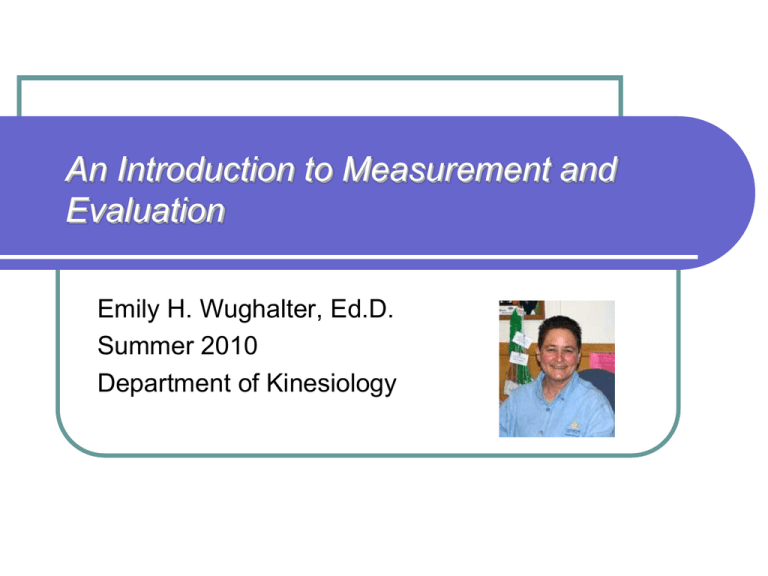
An Introduction to Measurement and Evaluation Emily H. Wughalter, Ed.D. Summer 2010 Department of Kinesiology Practice, Practice, Practice Focus Challenge Course Objectives Students will be able to: organize and describe data using descriptive and simple inferential statistics for research and evaluation in physical education, sport, and exercise science. apply measurement theory, i.e., reliability, validity, objectivity, and sensitivity to the subdisciplines of physical education, sport, and exercise science. appreciate the need for testing and evaluation, and good assessment practices in physical education and kinesiology. apply culturally sensitive tools and a sense of social justice in all measurement and evaluation practices. recognize the varying needs of individuals in movement and the need to develop effective measurement and evaluation tools for special settings. Course Requirements Examination 1 and Examination 2, 20 points each The first two exams will be held in class during Wednesday, June 14 and Wednesday, June 23 in the afternoon sessions, as scheduled on the course calendar. Exams will consist of multiple choice, short answer, and essay type questions. Essay questions will test mathematical computations. Both tests will be open card (to be explained in class) and calculators will be allowed. Examination 3, 30 points The final exam will be given in the morning of the final Wednesday, July 7. The final is comprehensive examination consisting of essay questions. Group Project, 25 points Each student will be assigned to a small group. This group assignment requires the design of a question to be tested, and a process for data collection and analysis. The design, procedure, analysis, and interpretation of data will culminate in a PowerPoint presentation to the class by all groups during class on Monday morning July 7. Group Project Evaluation, 5 points Each student is required to submit an assessment and a grade (A+ through F) for each group member. These grades and evaluations will be accumulated to provide 5% of the final grade. Measurement Measurement means a characteristic is defined and an instrument is selected to measure it, e.g., height can be measured with a tape measure, weight can be measured with a weight scale. Name some other things that we measure inside and outside of our field of kinesiology. Evaluation Evaluation means that you gather information to draw conclusions and make new predictions. Types of evaluation Formative evaluation Summative evaluation Places where measurement and evaluation are used: Research Education Business Sports Medicine Health and Rehabilitation Reasons for Measurement and Evaluation Motivation Accountability Equipment Placement Diagnosis Evaluation of learning Prediction Program Evaluation Standards of Measurement and Evaluation-Measurement Theory Reliability Validity Objectivity Sensitivity Ways of Describing Data Continuous scores - “… have a potentially infinite number of values, since they can be measured with varying degrees of accuracy”. Discrete scores - “… are limited to a specific number of values and are usually not expressed as fractions”. Baumgartner & Jackson Levels of Measurement Nominal Lowest level Ordinal Interval Ratio Highest level Nominal (categorical) scores - when a score places people or things into a category these are called nominal scores. Nominal scores cannot be ranked or ordered along any dimension. The categories must be exhaustive and mutually exclusive. Ordinal scores - means people or things are rank ordered along some dimension. No common unit of measurement exists between rankings in a system of ordinal scores. Comparisons cannot be made across different group rankings. Interval scores - These scores have a common unit of measurement between adjacent points. No true zero point exists on the interval scale. Ratio scores - These scores have a common unit of measurement between adjacent scores. Ratio scores have a true zero point. Standards for evaluation Standards set the bar for performance Norm referenced standards These kinds of standards are set by national, regional, local data collections and are determined by the number that the score is better than. Criterion referenced standards These kind of standards are set by national, regional, local data collections. A passing criterion or set of criteria are established in this form of standardization.

